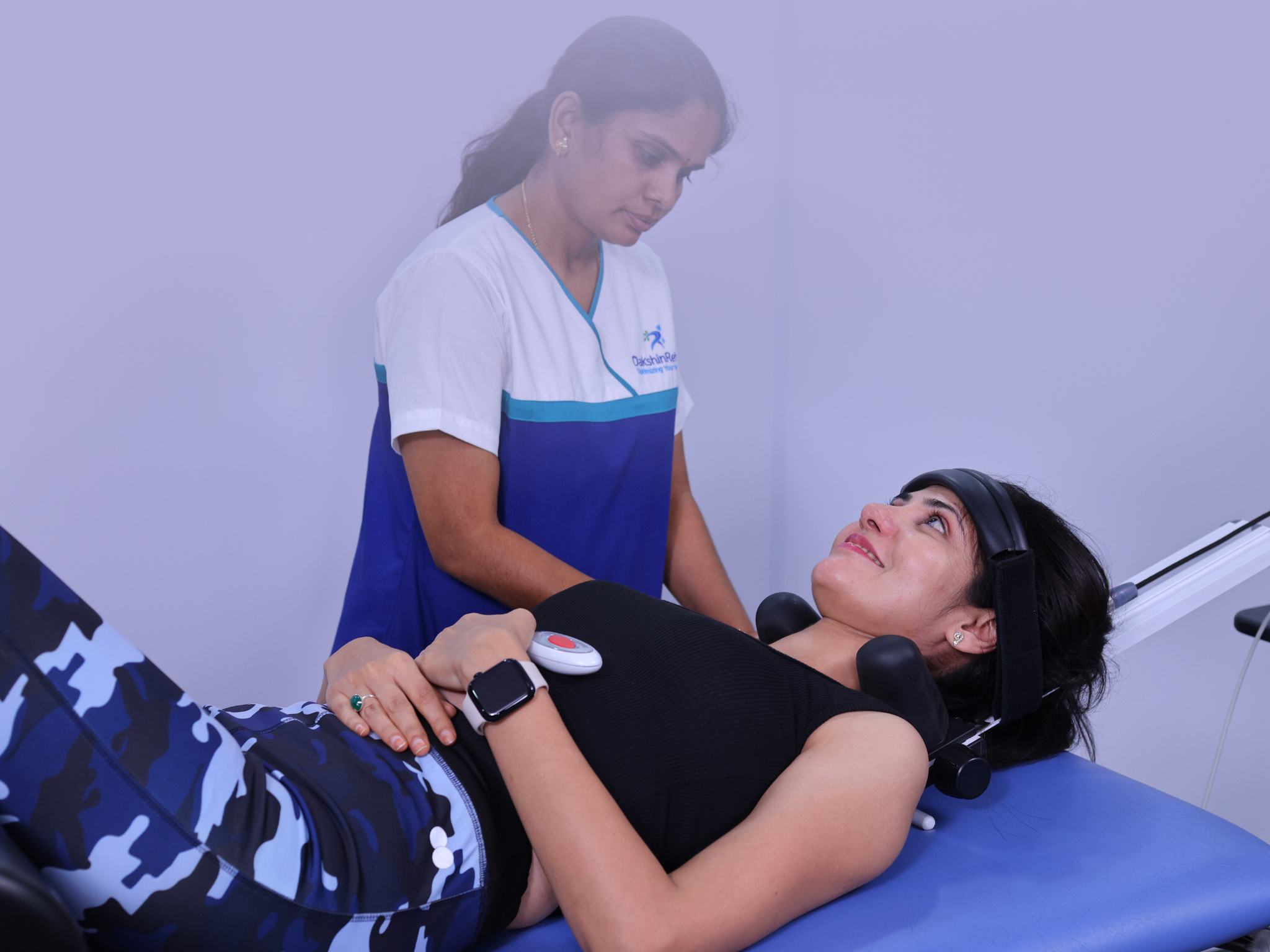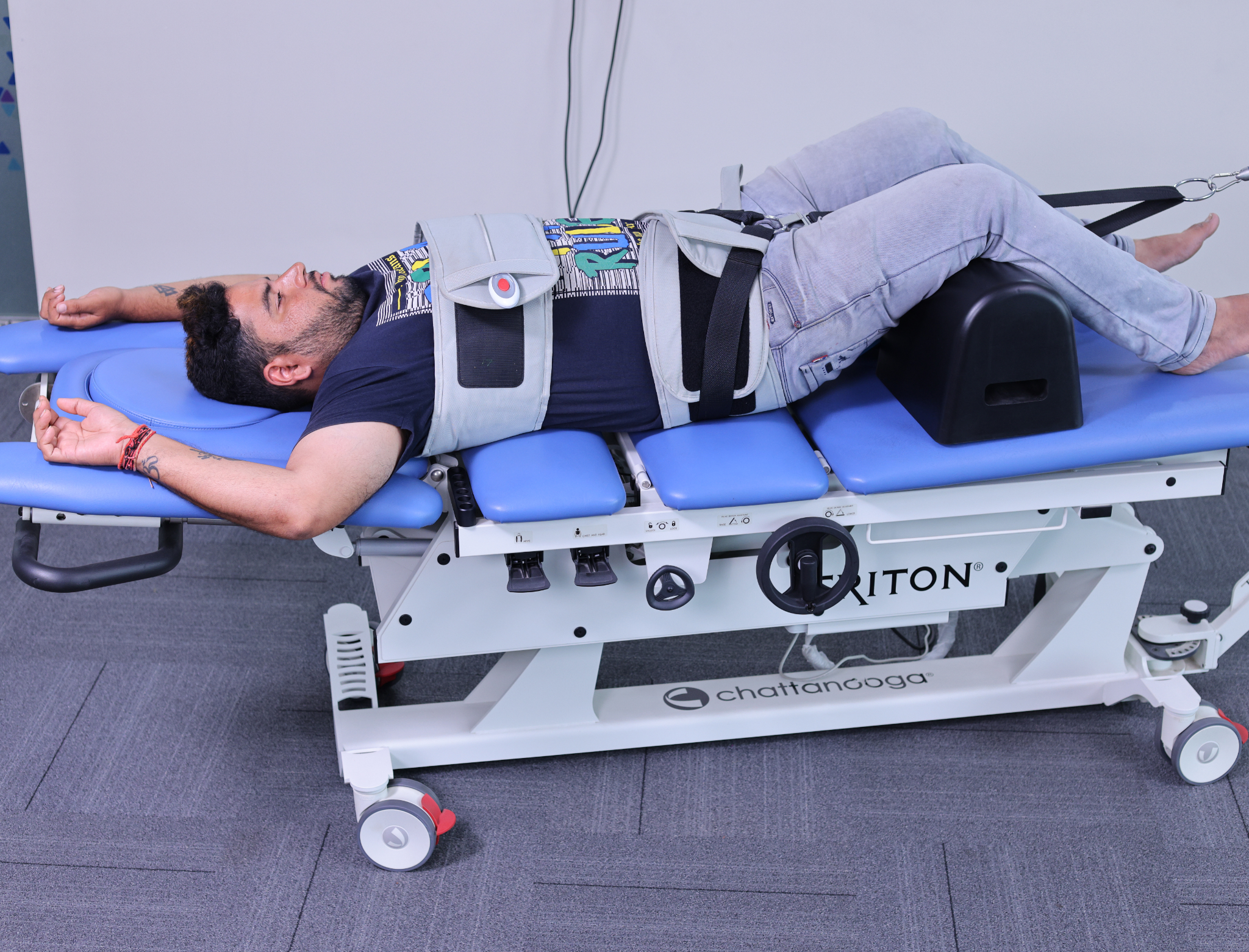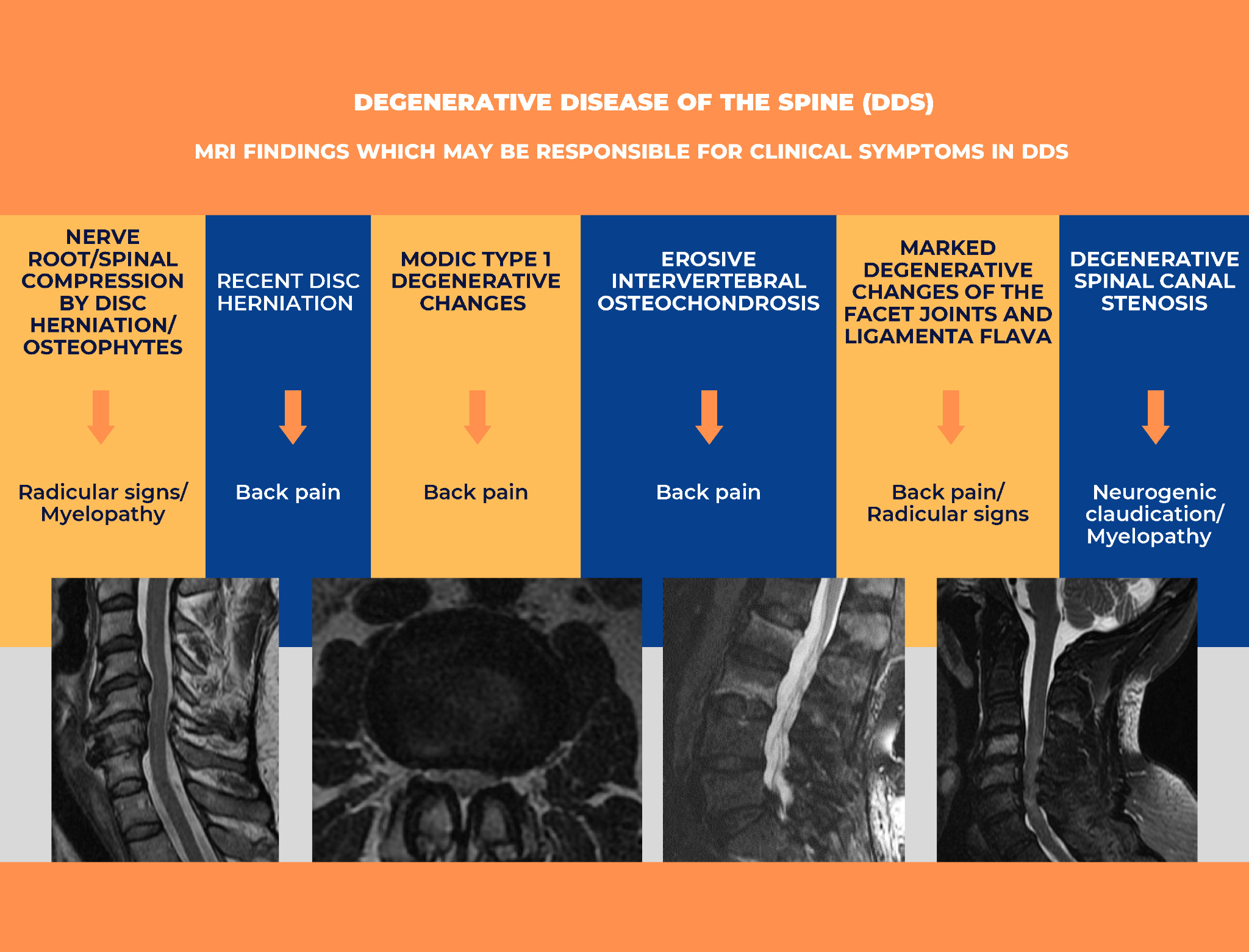The Science Behind DTS Spinal Decompression:
DTS spinal decompression therapy operates on several physiological principles, resulting in potential pain relief and improved spinal health:
Negative Pressure: By creating negative pressure within the spinal discs, this therapy aims to draw back bulging or herniated material into the disc. This process, in turn, reduces pressure on the nerves, potentially leading to pain relief and healing.
Blood Flow and Nutrient Delivery: DTS therapy can enhance blood flow and the delivery of essential nutrients to the affected area of the spine. This improved circulation can reduce inflammation and contribute to pain reduction.
Conditions Treated with DTS Spinal Decompression:
DTS Spinal Decompression Therapy Is Employed To Address A Variety Of Spinal Conditions, Including:
Sciatica: Sciatica involves pain that radiates along the sciatic nerve, typically caused by a herniated disc or bone spur in the spine. DTS therapy can help alleviate this condition.
Herniated Discs: Herniated discs occur when the soft inner material of a spinal disc protrudes through the tough outer layer. DTS therapy aims to draw the material back into the disc, reducing pressure on surrounding structures.
Degenerative Disc Disease: This condition involves the natural wear and tear of spinal discs, leading to pain and reduced mobility. DTS therapy can help mitigate the symptoms associated with this condition.
Spinal Stenosis: Spinal stenosis is the narrowing of the spinal canal, leading to pressure on the spinal cord and nerves. DTS therapy may offer relief by creating space within the spine.
How MRI Findings Aid in Identifying Degenerative Disc Disease:
MRI scans provide detailed insights into degenerative disc disease by highlighting key issues such as disc herniation, radiculopathy, and spinal stenosis. These imaging results help detect back pain causes, intervertebral osteochondrosis, ligamentum flavum thickening, and neurogenic claudication. Accurate diagnosis through MRI allows for targeted treatment, improving patient outcomes and pain relief.
- Nerve Compressions
- Spondylitis
- Numbness / tingling down arms or legs.
- Ligamentum Flavum
- Bulged Disc
- Low Back Pain
- Disc Prolapse
- Muscle Spasm
Who can Experience best results from Spine Decompression
DTS Therapy is your answer for non-surgical relief of lower back pain, sciatica pain relief, pinched nerve, lower back pain relief, neck pain relief, and more. Please Contact Us to learn all that DTS Therapy can offer you.
- Who find it hard to walk long distances without pain
- For whom the pain limits me interacting with family
- Who gets hurts while driving in the car
- Patient with previous failed treatment history.
- For whom the pain is now taking over their daily life
- Whom facing the prospect of back surgery
Facts Of Life:
DTS Therapy is your answer for non-surgical relief of lower back pain, sciatica pain relief, pinched nerve, lower back pain relief, neck pain relief, and more. Please Contact Us to learn all that DTS Therapy can offer you.
- Dangerous drugs such as NSAIDS destroy cartilage. Non-Surgical Spinal Decompression rebuilds cartilage.
- Surgery is Painful, Risky, and often times Unnecessary. Non-Surgical Spinal Decompression is Safe and Painless. Spinal Decompression allows most people to work during the treatment.
- Steroid Epidural Injections can cause nerve damage. Non-Surgical Spinal Decompression does not damage the nerves.
- Spinal Surgery causes lost time at work.
Phases of DTS Therapy
DTS Therapy is your answer for non-surgical relief of lower back pain, sciatica pain relief, pinched nerve, lower back pain relief, neck pain relief, and more. Please Contact Us to learn all that DTS Therapy can offer you.
- Phase I: Treatment
- Phase II: Stabilization of Structure
- Phase III: Support of Muscular System
PHASE I: The Treatment Begins
DTS Decompression Therapy is performed on a specially designed table in either a face up or face down position. Clinical consideration and your comfort are used in deciding which position will be best for you. We may begin in one position but in later sessions it may be necessary to change positions. You will remain fully dressed during the treatment though we recommend wearing loose fitting clothes, and removal of you belt and objects from your pockets..
You will be comfortably positioned on the table and fitted with a wrap-around harness. This restrain is what allows the unloading of the spine and discs by the traction motor. Your position on the table, the harness, and angle of the gentle distraction allows for accurate and focused treatment to the affected disc. Once comfortable on the DTS, the computer controlled traction device is programmed to deliver a gentle stretching force to the spinal vertebra.
This force is delivered directly to the harness system. The DTS system applies the gentle force then releases it approximately every minute throughout the session. The total treatment time is usually less than 18 minutes and often just 10 minutes initially. Most patients report simply feeling a subtle and gentle stretching at their lower back or around their hips. Since DTS Therapy is a comfort-based procedure, patients usually report a sense of relief and relaxation during the session. Many patients even fall to sleep.
Imbibing the Discs
The gentle stretching and relaxing of the spine fosters a phenomenon called “imbibition”. In the simplest of terms, this is the way a normal disc gets nutrition. This pumping action promotes nutrition intake into the discs, something often lost in damaged and degenerative disc conditions. In health discs, imbibition occurs naturally with daily motions and body positions and accounts for the increase of disc thickness in the morning and decrease at night.
A disc with poor imbibtion, fewer nutrients and hydration, is more likely to become injured and painful. Stretching or tractioning the spine in a controlled, comfortable manner can help re-establish a more normal imbibition. This can re-supply the disc with nutrients and blood contact that help the disc heal from the inside out. Also the dramatic decrease of pressure n the disc (decompression) can foster the drawing in of a bulge and help take pressure off a “pinched” spinal nerve.
Re-establish Structural Support
Although most patients report dramatic reduction of their pain within as few as five treatments, an injured spinal disc needs time to heal. This is why we urge you to be regular with your prescribed treatments and office visits. Research shows to completely heal some discs a regular program of home exercises, prescribed by your doctor will need to be followed. Spinal disc structures can take months to heal. Even though your pain may be gone, you must stay on the treatment plan in order to keep your spine healthy.
As you become more mobile and more able to return to your normal lifestyle, your increased activity is what your spine needs most. Now you will be imbibing the discs naturally, like people their healthy discs. Movement is life, and your spine depends on the muscle activity to support your spine, and create fluid movement to and from the discs..
PHASE II: Stabilization of Structure
Pain Is Under Control: Rehabilitate the Structures Supporting the Disc. Most patients feel significant pain reduction in as few as five DTS Therapy treatments. That however does not mean the healing process is complete, or that your pain won’t return.
During Phase II of your DTS Therapy treatments, our office will prescribe a series of rehabilitative measures in order to more fully heal your discs, and keep the pain from returning. Most low back pain suffers have two compounding problems that have contributed to their disc injury and limited their natural healing abilities.
- Decreased Spine Flexibility
- Poor Muscle Control
A program of focused rehabilitative exercise, with Biofeedback, may begin during or after your DTS Therapy course of treatment. Our rehabilitation program involves several clinically effective yet simple, pain-free activities including Biofeedback. Biofeedback allows you to monitor and control spinal motion and re-claim proper spinal movement patterns.
Strengthening the muscles that support the spine and regaining endurance in them, is also vital for spinal health.
All the body systems must work in concert for optimum health so nutritional and lifestyle advice may be given as well as an at-home exercise program. We can’t over emphasize the importance of the at-home exercises. What you do at home is integral to the overall success we have. Studies show consistent stabilization and endurance exercises control back pain and reduce injury. At what point you start the exercise program is a function of your pain and overall progress based on our findings..
PHASE III: Support of Muscular System
During Phase III, we’ll structure an in-office and home-based exercise program that will help to bring your spine back to full health. This exercise program may include in-office resistance training, at home Stabilizer exerciser and resistance training and other “core” exercises.
Regular and consistent home based exercise is one of the keys to long-term relief. We have found through experience the simple home-based exercises we prescribe are most effective. Introduction to the low tech movement exercises you can do to speed the healing process are one of the most important parts of the DTS Therapy System.
Health Tips & Info
We create personalized care plans for your specific spine condition, and we're here to answer all your questions and address your concerns. Our clinic in Hyderabad is recognized for providing excellent care and treatment, with a focus on improving recovery outcomes and patient well-being.
DTS (Decompression Traction System) spinal decompression therapy is a non-surgical approach to treat chronic back pain, neck pain, and spinal conditions. It involves the use of a traction table or machine that gently stretches the spine, creating negative pressure in the discs. This negative pressure can help relieve pressure on compressed nerves, herniated discs, and other spinal issues.
During a DTS therapy session, the patient is secured to the treatment table or machine using a harness or belts. The equipment then applies controlled and gentle traction to the spine, which is customized for each patient’s specific condition and symptoms. Sessions typically last 20 to 45 minutes and may be scheduled multiple times per week for several weeks.
DTS therapy works by creating negative pressure within the spinal discs. This negative pressure can help draw back bulging or herniated disc material, reducing pressure on nerves and promoting healing. The therapy also improves blood flow and nutrient delivery to the affected area, which can reduce inflammation and pain.
DTS therapy is generally considered safe and effective. However, it may not be suitable for individuals with severe osteoporosis, spinal fractures, or spinal tumors. It should only be administered by qualified healthcare professionals.
Yes, DTS therapy is considered a non-invasive and non-surgical alternative to surgery for many patients with spinal conditions.
Along with the damage in the disc we also need to treat the supporting spinal muscles. A complete program targeting the function of the stabilization muscles is a vital part of DTS Therapy. Our hope is not only to help heal the disc but enhance muscle control and support of the low back. A gradual breakdown of the foundational support of your back is what puts undue stresses on the discs and leads to pain and loss of function. Exercise and adjunctive therapies will assist in rehabilitating these structures.
Although it is difficult to predict the future, our experience is that most patients do find long-term relief or effective management of their pain when they complete the entire program of treatments. Regular home exercise and periodic visits to our clinic will help in maintaining your spinal health and reduce the probability of reoccurrence. As with any comprehensive rehabilitation program your continued home care exercises and discretion in some daily activities is key to long-term relief..
Our office visits vary as to the extent of care needed, (DTS Therapy, adjustments, massage, spinal rehabilitation, etc.). However, we promise to only do those procedures necessary for your fullest recovery. You always have the choice as to the extent of care. Our staff will review all costs, payment options and insurance coverage up front. We want to help, and believe finances shouldn’t stand in the way of you and good health.
Meet Our Doctors
Our administration and support staff all have exceptional people skills and trained to assist you with all medical enquiries.

Mohana Gandhi
Consultant Rehabilitation Prosthetist Orthotist

Swapna Gandhi
Human Movement Speicalist

Tanisha Mohanty
Physical Therapist.

Dr.Anand Wani
Pediatrician

Dr.Bhavin Ram
Vascular Surgeon

Dr.Sujith Omkaram
Pediatric Orthopedic Surgeon
Have Questions or Need Assistance?
Join the hundreds of people who’ve made the journey from painful to pain- free today




